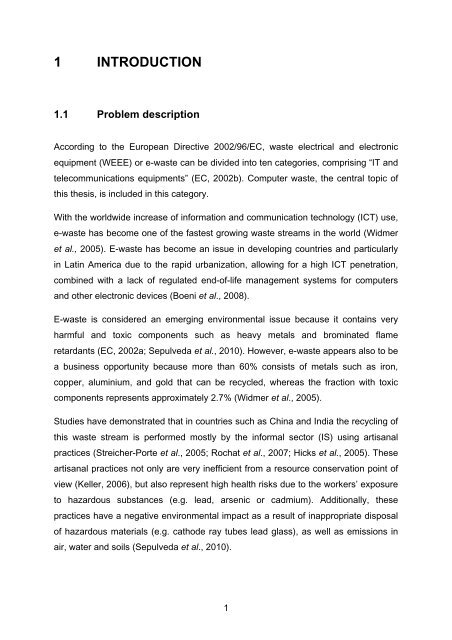10 07 29 Master thesis Juliana Leon - e-Waste. This guide
10 07 29 Master thesis Juliana Leon - e-Waste. This guide
10 07 29 Master thesis Juliana Leon - e-Waste. This guide
You also want an ePaper? Increase the reach of your titles
YUMPU automatically turns print PDFs into web optimized ePapers that Google loves.
1 INTRODUCTION<br />
1.1 Problem description<br />
According to the European Directive 2002/96/EC, waste electrical and electronic<br />
equipment (WEEE) or e-waste can be divided into ten categories, comprising “IT and<br />
telecommunications equipments” (EC, 2002b). Computer waste, the central topic of<br />
this <strong>thesis</strong>, is included in this category.<br />
With the worldwide increase of information and communication technology (ICT) use,<br />
e-waste has become one of the fastest growing waste streams in the world (Widmer<br />
et al., 2005). E-waste has become an issue in developing countries and particularly<br />
in Latin America due to the rapid urbanization, allowing for a high ICT penetration,<br />
combined with a lack of regulated end-of-life management systems for computers<br />
and other electronic devices (Boeni et al., 2008).<br />
E-waste is considered an emerging environmental issue because it contains very<br />
harmful and toxic components such as heavy metals and brominated flame<br />
retardants (EC, 2002a; Sepulveda et al., 20<strong>10</strong>). However, e-waste appears also to be<br />
a business opportunity because more than 60% consists of metals such as iron,<br />
copper, aluminium, and gold that can be recycled, whereas the fraction with toxic<br />
components represents approximately 2.7% (Widmer et al., 2005).<br />
Studies have demonstrated that in countries such as China and India the recycling of<br />
this waste stream is performed mostly by the informal sector (IS) using artisanal<br />
practices (Streicher-Porte et al., 2005; Rochat et al., 20<strong>07</strong>; Hicks et al., 2005). These<br />
artisanal practices not only are very inefficient from a resource conservation point of<br />
view (Keller, 2006), but also represent high health risks due to the workers’ exposure<br />
to hazardous substances (e.g. lead, arsenic or cadmium). Additionally, these<br />
practices have a negative environmental impact as a result of inappropriate disposal<br />
of hazardous materials (e.g. cathode ray tubes lead glass), as well as emissions in<br />
air, water and soils (Sepulveda et al., 20<strong>10</strong>).<br />
1
















